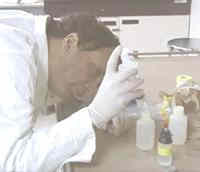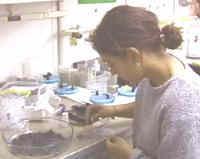| |
Participant
Interview:
Kim Juniper
Biologist
University of Quebec
Jeff: You've been studying
hydrothermal vents for about 15 years. How did you get started in this
type of research?
Kim: I came out to Axial Volcano in the summer on 1983 with Verena Tunnicliffe
and four other scientists and we made the first discovery of a vent system
in the North Pacific. The vent is called CASM and is in the northern part
of Axial's caldera. I got hooked and I've been studying vents ever since.
It was natural for me to come out to the vents. Before I'd been working
with chemosynthetic bacteria and using a submersible a lot.
Jeff: How has hydrothermal
vent research changed over the last 15 years?
Kim: Technology has changed the most in the last five years with the advent
of ROV's which allow everybody to get involved on every dive. The first
ten years of vent research were exploration, mapping, inventory of species
and sites and discovering symbiosis. Now were starting to ask questions
that we would normally ask about any ecosystem. There is great interest
in trying to understand how the environment varies in time, from both
the earth scientist's point of view and the biologist's point of view.
Jeff: What research are
you and your graduate students working on this year at Axial?
Kim: We're concentrating this year on finishing up a project which involves
looking at how food chains develop as new vents are formed and colonized.
We're also trying to understand how the animals work out their social
arrangements. Obviously we expect vent communities to become more complex
after an eruption because they're starting with a clean slate (fresh lava).
Jeff: What has kept people's
interest in hydrothermal vents since their discovery in 1977?
Kim: Obviously, the discovery of a new ecosystem is in the interest of
everyone in terms of basic science. But that's all over. We've moved on
from that discovery phase. I think what's been keeping people going now
is the extreme nature of the environment compared to what we know elsewhere
on Earth. In terms of biodiversity in this environment, its not the numbers
of species, but their adaptations and the novelty of what they do to survive
and thrive in this environment.
|
|

Kim Juniper working on specimens
in the Biology Lab on the Ron Brown.

Marie Maineaux, Kim's graduate student, sorting sulfide worms.
|
|

